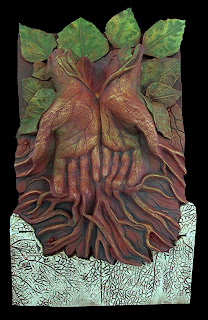(Performed with drum
in a much darkened room.
Three voices,
at different positions in the room, speak the words, sometimes in Chorus.)
Take a deep breath,
feel your feet on the living Earth.
The rhythm of your heart like a drum,
beating in slow time with the quiet,
distant heartbeat
of the planet:
and
attune.
Let the breath of the world gather in your
chest.
Close your eyes, with each slow breath
feel your hands branching,
becoming green, leafing into the world,
gathering wind, gathering light, gathering rain
-
feel your legs, your strong feet grasping the
ground
becoming roots:
and send them down.
Into the darkness, our roots, seeking,
sensitive,
into the Earth.
Into silent endarkened underground waters
coursing past pottery shards, and the bones of
ancient deer
and the bones of ancient hunters, the bones of nameless
kings.
Past the bones of cities long forgotten,
and caverns of crystals blooming in the dark
the bones of the dreaming Beloved, the Mother
Earth:
go down, taste, touch:
and
attune.
Feel the roots of a vast forest
holding each tree strong in times of storm,
singing under starlight, or sleeping under snow
-
a woven web of roots.
Feel the links, the communion, the sparking
touch
of other lives, the lives of the land.
Reach out, expand, listen:
and
attune.
Somewhere in the East a woman rises to make
bread for her family.
Somewhere in the South a child plays in the warm
dust.
Somewhere far to the West a girl in a red sari
prepares for her wedding, gathering yellow marigolds.
Somewhere in a Northern city, a painter stands
before an empty canvas,
trying to remember a dream he had. He lifts his brush.
Follow your roots, touch their delight.
and attune
Somewhere in the Southern Hemisphere a forest is
screaming as it burns.
Somewhere in the West, a homeless man is dying
alone and in great pain.
Somewhere in the East war has come to the
innocent.
Somewhere in the North acid rain falls, and a
lake has become barren.
Open your heart, touch and taste, allow it:
and
attune.
And somewhere in the South, spring is beginning,
magenta blossoms fall on a green lawn.
Somewhere in the North winter is coming,
crimson leaves fall on a dappled pavement.
Somewhere in the West the sun is going down.
Somewhere in the East, the sun is rising.
Reach,
feel the beat, the rhythm,
the circling coursing of life: follow your roots
back, back with every beat,
back to the solitary beat of your heart.
and attune
to the beat of our common heart.
Gather hope, awe, and gratitude.
Gather your strength, sap, sorrow, your love.
With hands on the holy ground,
feel the beat, the pulse of the living Earth.
And send
it down:
Into the Earth, the best of us,
into the Earth, our roots,
into the Earth, our dreams,
into the Earth, our source.
into the Earth, our love.
into the Earth, our light.
Lauren Raine
(1999,
2016)
Copyright
Lauren Raine MFA.
Artwork is
copyright Lauren Raine MFA.
























